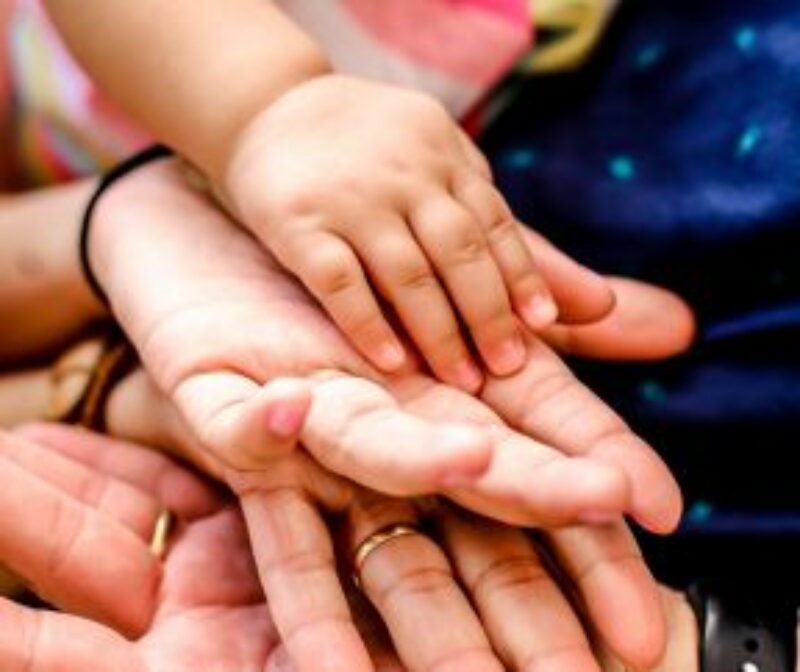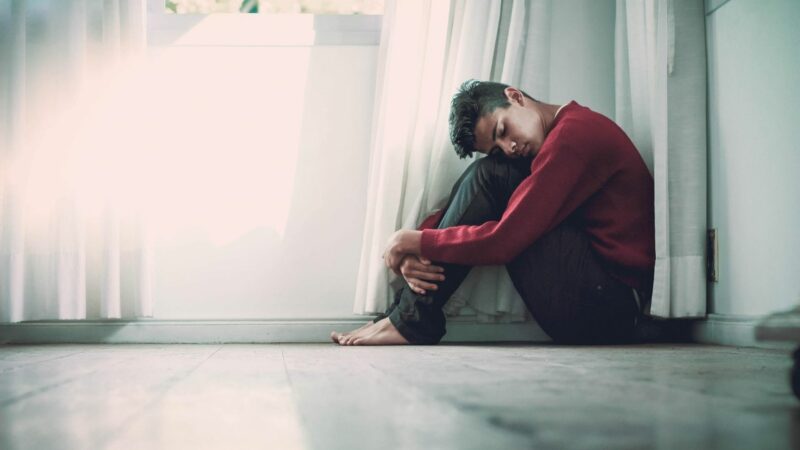According to research on child development, children respond to stress and stressful events in their own unique ways. During times of stress, your child may become more angry, anxious, clingy, or may even develop fears concerning their danger and death. Your child’s behavior may also change during this time. They may start exhibiting behaviors such as bedwetting, difficulty sleeping, difficulty concentrating, throwing tantrums, or fighting with their siblings more than usual. Each of these responses (and many others) are considered normative responses to stress.
Cognitive behavioral treatments (CBT) are considered the best studied and most effective treatments for children with anxiety1. According to CBT for children, children’s thoughts about anxiety-inducing situations will affect their feelings and behaviors in response to it. In other words, the way your child thinks will impact how they feel and act. For example, your child may develop a negative belief that they can’t handle the situation, which may cause them to feel helpless and scared, or may cause them to respond by throwing a tantrum. CBT works by teaching your child how their thoughts affect their feelings and behaviors. When children understand the connection between their thoughts, behaviors, and feelings, they can then learn how to change unhelpful and negative thoughts or behaviors, and learn to manage their emotions.
Here are three step-by-step interventions, based on CBT and other evidence-based treatments, that you can use at home to help regulate your child’s and your own stress during this time:
1. Conduct a parent emotional check-in.
Parents, it is important for you to be aware of the times when you may feel anxious and overwhelmed, as this will impact your ability to respond to your child’s stress in appropriate and helpful ways.
Start by taking a slow, deep breath, to the count of five. Then, bring your attention to your feelings and thoughts in the present moment and ask yourself:
- “How am I feeling right now?”
- “What do I need for myself right now?”
- “Do I have the capacity to respond to my child’s behaviors?”
- “What do I need to be able to engage with my child right now?”
As you become aware of your own anxiety and stress in the moment, you can start to think about ways you can regulate your own emotions. Giving yourself a moment to breathe and getting more in touch with how you are feeling is the first step to helping your child regulate their emotions.
2. Respond to your child’s emotions.
Your child’s thoughts during this time will impact their emotions. Your child may be experiencing higher levels of fear, nervousness, insecurity, anger, or frustration. Parents, it is important to respond to these emotions in a way that helps your child understand what they are feeling, so that your child can learn how to regulate their emotions2.
- To begin, be curious about your child’s emotional experience.
Children’s behaviors and emotions communicate many different things. Your child may be anxious or scared because of the changes they are experiencing, or they may just be hungry and tired at the end of a long day! When your child is exhibiting a behavior that is problematic (e.g., throwing a tantrum, hitting their sister/brother, screaming at the table), it is important to be curious about what they are trying to communicate to you through their emotional experience.
- “I see that you are mad/frustrated/scared.”
- “That is a big feeling.”
- “I wonder what happened right before [the behavior]?”
- “How are you feeling right now?”
Helping your child identify their emotions has been shown to positively impact their emotion regulation abilities3.
- Empathize with your child’s emotional experience.
Parents, before correcting your child’s behavior, it is important to demonstrate to your child that you understand what they are feeling and why they might be feeling that way. Doing so helps your child to feel more comfortable to explore the emotions behind their behaviors, and will help them trust that you will accept their feelings.
Tell you child:
- “I understand why you feel that way.”
- “I understand why you feel scared/angry right now.”
3. Educate your child about anxiety.
Everyone is designed to experience healthy, adaptive levels of fear. Fear is activated by the autonomic nervous system, which helps prepare the “fight-or-flight” response. However, fear is different than anxiety. Anxiety is an emotion that is characterized by feelings such as tension, uneasiness, apprehension, and worry about a future negative situation or event. As discussed above, anxiety is thought to consist of three components: thoughts, behaviors, and emotions. Your child may have distressing thoughts, images, or beliefs about the future situation causing discomfort and fear. In addition, they may display behavioral reactions including avoidance, escape, crying, clenching their jaw or balling their fists, or developing walking rituals. Lastly, your child may experience physiological sensations such as fidgeting, increased heart rate, muscle tension, profuse sweating, or rapid breathing. If your child is anxious, they may also experience difficulty sleeping and poor conception4.
- First, help your child identify cues of their anxiety, such as how their body feels and the thoughts they have when they are anxious.
- “How does your body feel when you get scared?”
- “Where in your body does it feel like that?”
- “What do you start to think about when you feel scared?”
These questions will help your child identify how their body feels when they are anxious, locate the source of the anxiousness in their body, and track the thoughts that arise when they feel anxious.
- Next, model and encourage your child to develop coping skills.
Communicate your emotional experience to your child. Parents, when you recognize your own emotions, this helps your child to become aware of their own emotions as well. You can start by telling your child, “Sometimes I feel angry/scared/nervous, too.”
When you share and/or label your own emotional experience, you help to make “big emotions,” such as anxiety or anger, more acceptable and less overwhelming for your child. When emotions are discussed with understanding adults, they are more easily understood and experienced, which in turn makes them easier to regulate.
After sharing your emotions, it is important to also model to your child effective emotion regulation skills. Teach your child the ways in which you cope with emotions, and encourage your child to develop their own ways to manage their own emotions.
Start by telling your child:
- “When Mommy is feeling scared, she goes for a walk to feel better,” or
- “When Daddy is overwhelmed, he counts to ten to feel better.”
Then ask your child: “What are some things that…”
- “…help you feel better?”
- “…you can do to feel better?”
- “…I can do to help you feel better?”
Parents, it is critical that you respond to your child’s stresses and behaviors in healthy ways. Conducting parent emotional check-ins, empathizing with your child’s emotions, and educating them about anxiety will decrease the amount of stress that you and your child are experiencing and model to your child ways that they can cope with stress in the future.
References
1. Albano, A. M. & Kendall, P. C. (2002). Cognitive behavioural therapy for children and adolescents with anxiety disorders: Clinical research advances. International Review of Psychiatry, 14, 129-134.
2. Meyer, S., Raikes, H. A., Virmani, E. A., Waters, S., & Thompson, R. A. (2014). Parent emotion representations and the socialization of emotion regulation in the family. International Journal ofBehavioral Development, 38(2), 164-173.
3. Hoffmann, J. & Russ, S. (2011). Pretend play, creativity, and emotion regulation in children. Psychology of Aesthetics, Creativity, and the Arts, 6(2), 175-184.
4. Schroeder, C. S. & Smith-Boydston, J. M. (2017). Assessment and treatment of childhood problems: A clinician’s guide. (3rd Ed.). New York: Guildford Press
About the Author

Hannah Ewert
Hannah Ewert is a PsyD candidate in the clinical psychology program at Fuller’s Graduate School of Psychology. Her research focuses on the impact of early relationships on child and adolescent mental health. As a clinician specializing in the care of children and adolescents, Hannah is interested in helping children flourish, and works to integrate research and clinical practice in order to help children and their families thrive.
Continue Exploring

Emotions
Kids and Anxious Minds (Part 2): Practices to Help Kids Cope During Times of Anxiety
Student researchers share 3 research-based techniques to increase relaxation, support positive behaviors, and create a structured routine for kids.

Youth
Kids and Community (Part 1): How to Find the Right One for Your Kids to Thrive
How do you find a community to support your family? What kinds of support help families grow spiritually healthy and thrive.

Youth
Kids and Community (Part 2): Adolescents and the Value of Loving Relationships that Display a Loving God
Why do kids need a community that models love, and what does emotional safety have to do with it. Part 2 of a 3-part series.

